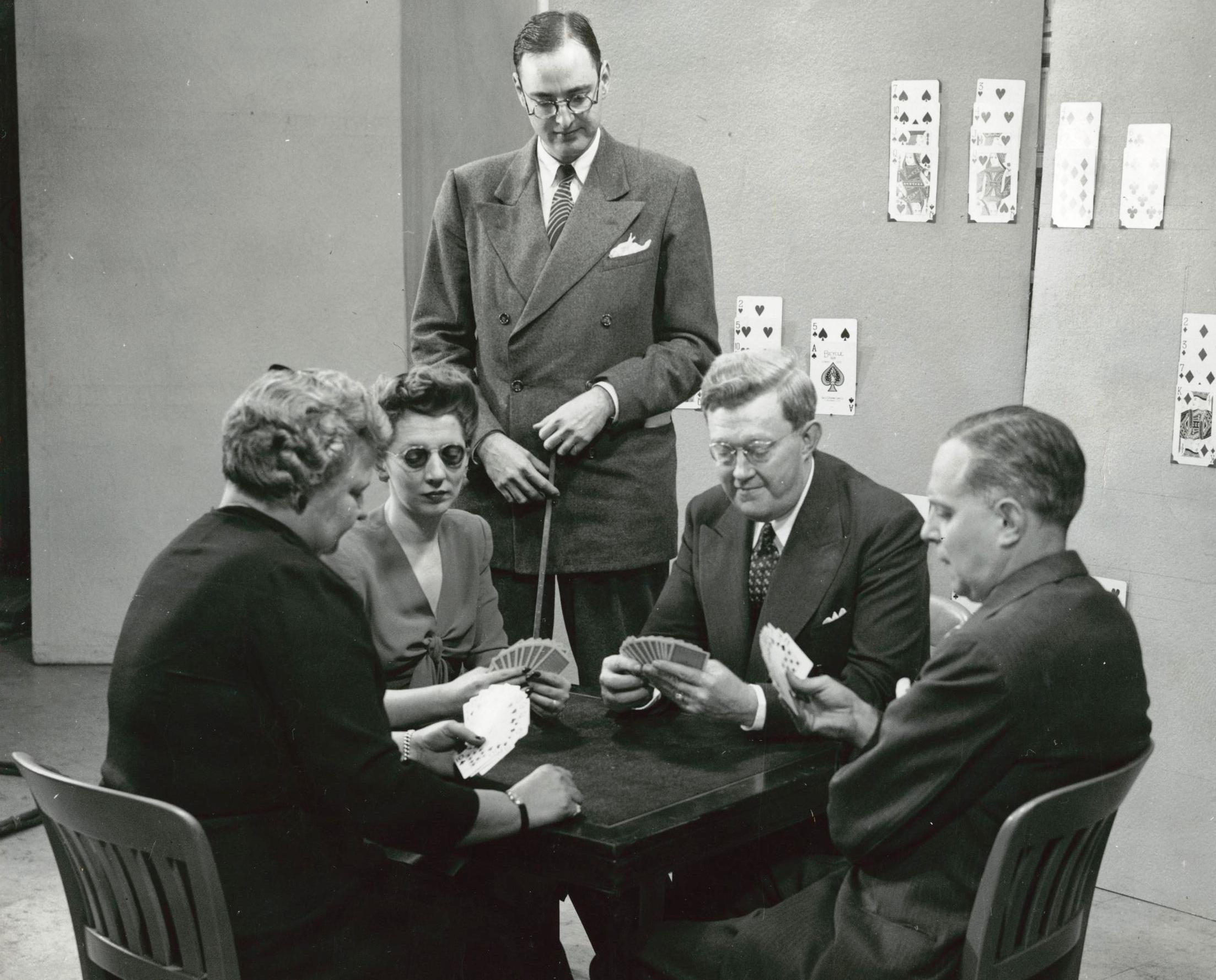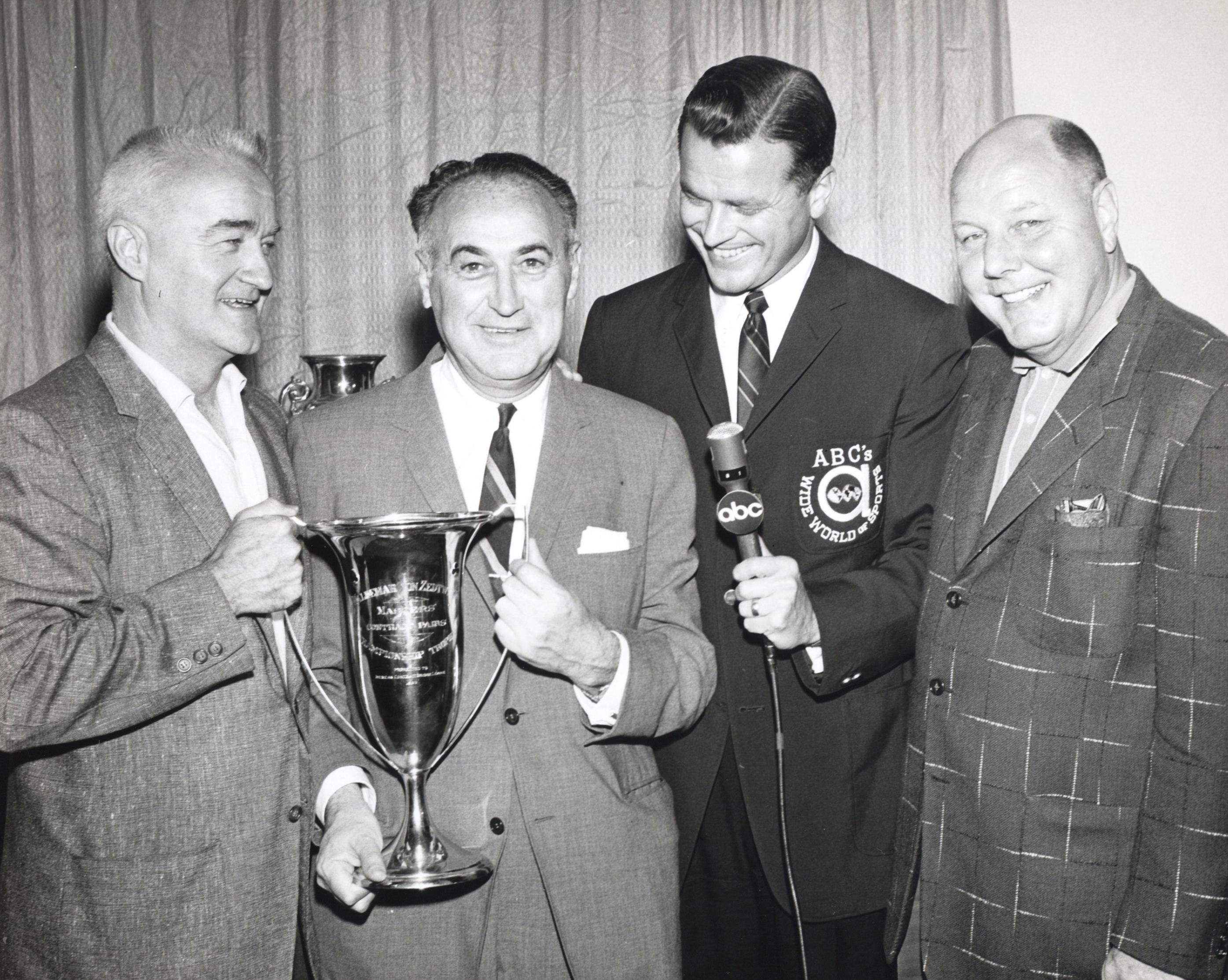The first time bridge appeared on television was October 7, 1943. William McKenney and his wife Marguerite played Al Sobel and Helen Sobel on Station WRGB, Schenectady NY. Albert H. Morehead analyzed the bidding and the play.
The match, designed as an experiment, was arranged by J. Walter Thompson Co. for the American Playing Card Manufacturers. The players used regular sized cards with jumbo pips. These cards were known as “kibitzer specials” and could ordinarily be seen from a distance of 15 feet. The hands were also arranged on a board with large jumbo cards.
All of those participating in the broadcast were convinced that television provided a feasible means of teaching bridge. But they awaited a winning formula.
Many of the early bridge shows generated numerous calls and letters, but most of the programs were one-shot deals. Bridge enthusiasts agreed that peering over the shoulder of a player, especially an expert, was fun. Watching bridge on TV, kibitzers could be vocal and active without disturbing the players. The interest in watching good bridge competition motivated a number of stations during the late 1950s and early 1960s to present live bridge telecasts.
Manhattan’s WOR-TV is generally credited with starting the trend by filming players battling for the Manhattan Championship. Billy Seamon was the commentator. NBC’s Tonight cameras aired segments of the final of the Eastern States Championship in New York with commentary by Goren and by syndicated bridge columnist and author Alfred Sheinwold. In 1957, the final of the Iowa State Team Championship was televised live, with commentary from Dr. John Gustafson of Des Moines. WCCO in Minneapolis televised the Twin City Team final, importing Goren for the show. In 1958, KTTV aired live a portion of Los Angeles Bridge Week, which was acclaimed technically as the best bridge shown to that point. The final of the von Zedtwitz Life Master Pairs was aired on ABC’s Wide World of Sports in 1963.
Local programs were appearing in other markets, and bridge was a hot ticket. KPTV in Portland featured Sam Gordon’s Horse Sense Bridge, the first recorded effort to give formal bridge lessons on television. Sam taught a beginner’s lesson for the first half, and this was followed by actual play. KQED, Channel 9 San Francisco, in combination with KVIE, Channel 6 Sacramento, ran a TV bridge program designed by Ernest Rovere on Thursdays for 26 weeks. This was done in combination with the San Francisco Chronicle, which published a quiz based on the preceding night’s program. Viewers were invited to mail their answers to the quiz show.
Bridge found its first home on public television in 1974. Duplicate bridge was welcomed to the small screen when the Charlotte NC Bridge Association staged a show on KTVI, an educational channel. The program was geared toward rubber bridge and social bridge players who had never tried duplicate. In 1975, Play Bridge with the Experts ran on KUHT in Houston. John Gerber was the expert consultant. Each of the 26 shows featured a different guest expert. Ed Allen of Beaumont, head of Educational Television Productions, created the series.
Eddie Kantar was the host-narrator of Master Bridge, which was developed in 1978 by Barbara Warner, executive producer of Jack Warner Productions. In 1983, Mary McVey, a bridge teacher from Lexington KY, filmed seven half-hour instructional shows called Basic Bridge for KET-Kentucky Educational Television. McVey hosted an additional 14 shows in 1984 called Play Bridge. Both shows were carried by more than 100 public television stations and later appeared on The Learning Channel.
In 1986, ACBL funded McVey’s third show, Play More Bridge, a 13-installment series of bridge lessons for intermediate players. In 1989, ACBL began a campaign to develop new players through television bridge lessons. This time, the audience were people who had never played bridge and social/rubber bridge players looking for a review of the basics.
ACBL’s first effort was The Bridge Class, 13 half-hour shows based on ACBL’s beginning bridge text, The Club Series, by Audrey Grant. The series presented bridge as fun and easy to learn in an upbeat setting. It found its first audience on The Learning Channel. In 1991, it was picked up by the PBS affiliate SECA, the Southern Educational Communications Association, currently known as NETA. It enjoyed an impressive reception on public television stations. Using material from ACBL’s second and third beginning bridge texts, The Diamond Series and The Heart Series, 26 half-hour shows known as Play Bridge with Audrey Grant hit the airways in 1993 and 1994 with the help of WITV in Harrisburg PA.
In 1996, ACBL, in association with Audrey Grant and independent film and video producer Jeff Drzycimski, produced a fourth television series entitled Bridge Brush-Up.
Perhaps the biggest TV bridge show ever produced occurred during the Bermuda Bowl World Championship in Beijing, China, in 1995. Play-by-play shows were sent out over the national network on several days, and it was estimated that more than eight million Chinese bridge players watched the show. China Cup matches in later years also were featured on national television.


